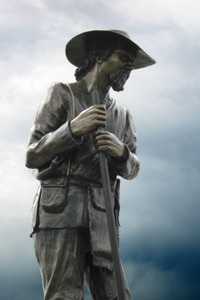Jim Baker (frontiersman)
Jim Baker (1818–1898), trapper, scout and guide, was a friend of Jim Bridger and Kit Carson and one of General John C. Fremont's favorite scouts. He was one of the most colorful figures of the old west.
Born in Belleville, Illinois, at 21 he was recruited by Jim Bridger as a trapper for the American Fur Company and on May 22, 1839 left St. Louis with a large party heading for the annual rendezvous in the mountains. In August 1841 he was involved in a desperate fight at the junction of Battle Creek and the Snake River when 35 trappers beat off a large band of Sioux, Cheyenne, and Arapaho.
The decline of the fur trade in the early 1840s drove many the trappers to quit, but Baker stayed on. Little is known of his movements after 1844, but in 1855 he was hired as chief scout for General William S. Harney of Fort Laramie, and he was part of the Federal Army sent against the Mormons. In 1873 he built a cabin with a guard tower near the Colorado Placers of the Little Snake River in Wyoming where he raised livestock until his death in 1898. His cabin is currently on display at the Little Snake River Museum in Savery, Wyoming. His grave marked with a stone near Savery, Wyoming.
Baker was married twenty times, each time to an Indian woman, one of whom was the daughter of a Cherokee chief; he had a number of children. Another of Baker's wives was a daughter of Shoshone Chief Washakie.

Biography
1818, Jim Baker of Scotch -Irish descent was born in Illinois. At an early age he traveled on foot to St. Louis Missouri where he met Jim Bridger. This was a beginning of a new adventure as Baker signed a contract with the American Fur Company to join a trapping expedition.
May 25, 1839, on the old steamer St. Peter traveling up the Missouri to Kansas City, the party was transported on keel boats traveling to Grand Island on the Platte River, reaching the Laramie Plains. They continued down the Medicine Bow and Laramie Rivers to Sweetwater, crossing South Pass to arrive at Fort Bonneville.
1838 to 1839, Baker hunted and trapped the Wind River Mountains. When spring broke in 1840 he returned home to Illinois.
Spring of 1841, Jim set out for his second journey to the Rocky Mountains, traveling back across the Laramie Plains, over South Pass, down the Green River to Bridger's camp at the Henry's Fork. Bridger, who was worried about his associate Henry Frapp sent Baker along with others to search for the lost party who had been trapping at the Base of Squaw Mountain on the banks of the Little Snake River.
August 21, 1841, Jim Baker noticed a cloud of dust arising on the southwest side of Bastion Mountain. A shower of arrows came from a cliff overhead, they had encountered hostile group of Sioux, Cheyenne, and Arapaho warriors. Captain Frapp died early in this fight leaving Jim Baker at the age of 21 to take charge. This battle gave a new name to Bastion Mountain, now known as Battle Mountain.
August 27, 1841, after the warriors retreated the trappers departed from Battle Mountain and returned to Bridger's camp.
1847, Baker settled for a short time in Salt Lake City, Utah where he became a government Scout and guide. His fluency in the Shoshone language and use Arapahoe sign as well as his knowledge of the rivers, trails, mountains and Indian War trails led him for Old Mexico where he returned with a regiment of soldiers to Fort Bridger. General Johnson who was in command of an army sent to install a new governor in Utah because President James Buchanan believed that the Mormons would forceably resist the replacement of Brigham Young as territorial governor (see Mormon War).
In 1859 Baker took up homestead near Denver three miles north on Clear Creek. He built an adobe brick building at what is now 53rd and Tennyson Street, just west of the campus of Regis University. He built a toll bridge as well as owned the first coal mine in Colorado where Ris is now, 18 miles west of Denver. This same year Baker was appointed a captain in the Colorado Militia along with John Chivington who later lead Colorado forces at the Sand Creek Massacre.
In 1873 Baker left Colorado and bought a ranch near Savery, Wyoming, he built a cabin from cotton wood trees that he chopped along with his three daughters, Isabel, Madeline and Jennie. The cabin had three stories, the upper was used as a watch tower but as the threat of hostility gave away the third story was removed.
1875, Jim Baker served under General George Custer as a scout during the Fight at Rosebud in the Black Hills.
1881, Jim Baker once again was ask to aide in yet another Battle, The Meeker Massacre led by General Thornburg.
May 15, 1898, Jim Baker died in his cabin near Savery, Wyoming. Loved and respected by many, he was known as Honest Jim Baker. His body was laid to rest in a small cemetery overlooking the Little Snake River Valley.
1917, The Baker Cabin was removed from Savery and taken to Frontier Park in Cheyenne, Wyoming.
July, 1976, the home of Jim Baker returns home to Savery Wyoming and is now located at the Little Snake River Museum. The cabin was reconstructed under the direction of Jim Baker's Great-Grandson Paul McAllister who still lives in Dixon Wyoming.
External links
|